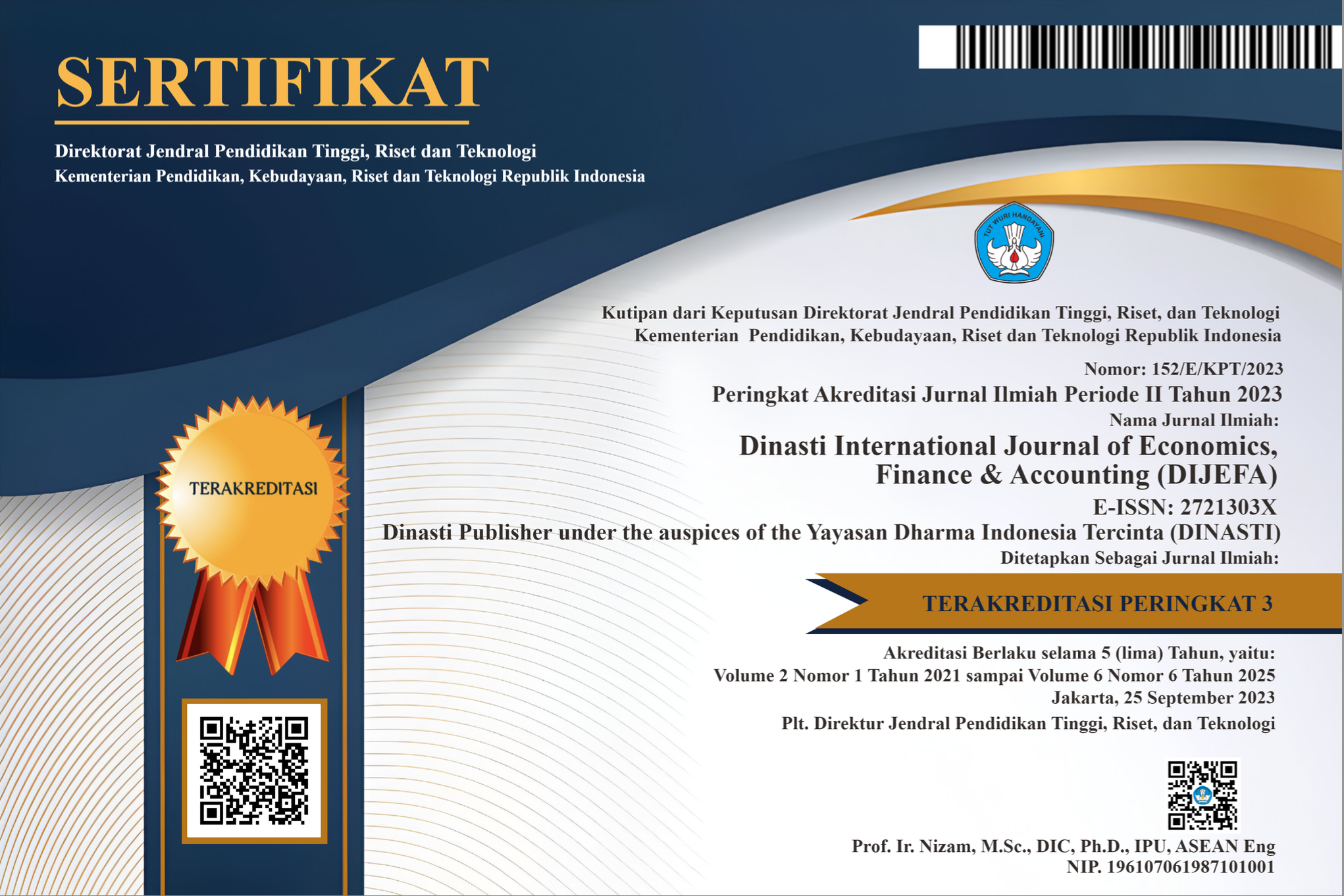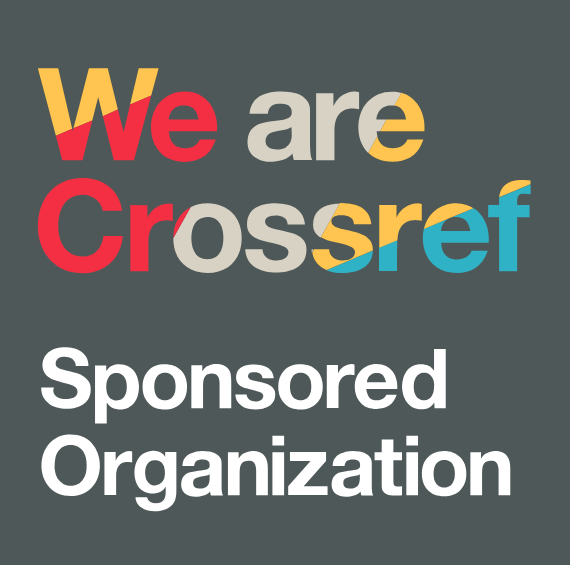HOW TOP MANAGEMENT TEAMDIVERSITY INFLUENCES COMPANY PERFORMANCE?: THE CASE OF INDONESIAN STATE-OWNED ENTERPRISES HOLDING
DOI:
https://doi.org/10.38035/dijefa.v1i2.267Keywords:
SOE Holding, TMT, corporate culture and performanceAbstract
The research conducted at SOEs Holding aims to analyze the effect of TMT diversity on company performance. The research samples are forty Indonesian SOEs that incorporated into four SOEs Holding that surveyed through the questionnaire. The data analysis technique uses Structural Equation Model (SEM) with SmartPLS. The results concluded that TMT diversity had a significant effect on corporate culture, which mediates TMT diversity’s significant effect on company performance. Nevertheless, without corporate culture as the mediating variable, TMT diversity has no significant effect on company performance.
References
Aliyu, M. A. (2016). Modelling Total Quality Management Dimensions for Sme. Journal of Education and Social Sciences., 3(1995), 165–169.
Amasaka, K. (2013). The Development of a Total Quality Management System for Transforming Technology into Effective Management Strategy. International Journal of Management, 30(2), 610–631.
Bantel, K. A., & Jackson, S. E. (1989). Top management and innovations in banking: Does the composition of the top team make a difference? Strategic Management Journal, 10(1 S), 107–124. https://doi.org/10.1002/smj.4250100709
Camelo, C., Fernández?alles, M., Hernández, A. B., & Fernández-Alles, M. (2017). International Journal of Manpower Strategic consensus, top management teams, and innovation performance) “Strategic consensus, top management teams, and innovation performance” Strategic consensus, top management teams, and innovation performance. International Journal of Manpower Journal of Management Development European Journal of Innovation Management, 31(19), 678–695. Retrieved from https://doi.org/10.1108/01437721011073373705
Carpenter, M. A., & Sanders, G. (2002). Top management team compensation: The missing link between CEO pay and firm performance? Strategic Management Journal. https://doi.org/10.1002/smj.228
CERTO, S. T., SIRMON, D. G., & BRYMER, R. A. (2010). Competition and Scholarly Productivity in Management: Investigating Changes in Scholarship from 1988 to 2008. Academy of Management Learning & Education, 9(4), 591–606. https://doi.org/10.5465/AMLE.2010.56659878
Chin, W. W. (1998). The Partial Least Squares Approach to Structural Equation Modeling. New Jersey: Psychology Press.
Combs, J. G., Crook, T. R., & Shook, C. L. (2005). The dimensionality of organizational performance and its implications for strategic management research. In Research Methodology in Strategy and Management (pp. 259–286). https://doi.org/10.1016/S1479-8387(05)02011-4
Creswell, J. W. (2014). Research Design: Qualitative, Quantitative and Mixed Methods Approaches (4th ed.). London: Sage.
Das, A., Paul, H., & Swierczek, F. W. (2008). Developing and validating total quality management (TQM) constructs in the context of Thailand’s manufacturing industry. Benchmarking: An International Journal, 15(1), 52–72. https://doi.org/10.1108/14635770810854344
Douglas, T. J., & Judge, W. Q. (2001). Total Quality Management Implementation and Competitive Advantage: the Role of Structural Control and Exploration. Academy of Management Journal, 44(1), 158–169. https://doi.org/10.2307/3069343
Ferreira, J., & Azevedo, S. (2007). Entrepreneurial orientation as a main resource and capability on small firm’s growth.
Finkelstein, S., Hambrick, D. C., & Cannella, A. A. (2009). Strategic Leadership: Theory and Research on Executives, Top Management Teams, and Boards. Theory and research on executives, top management teams, and boards. Retrieved from http://www.worldcat.org/oclc/224445907
Franzoni, S. (2013). Measuring corporate culture. Corporate Ownership and Control, 10(4 D,CONT3), 308–316. https://doi.org/10.1111/j.1468-2370.2009.00274.x
Frohman, A. L. (1998). Building a Culture for Innovation. Research Technology Management, 41(2), 9–12.
Gallén, T. (2009). Top management team composition and views of viable strategies. Team Performance Management, 15(7/8), 326–342. https://doi.org/10.1108/13527590911002113
Ghozali, I. (2014). SEM Metode Alternatif dengan menggunakan Partial Least Squares (PLS). Semarang: Badan Penerbit Universitas Diponegoro.
Hambrick, D. C. (2007a). Upper echelons theory: An update. Academy of Management Review. https://doi.org/10.5465/AMR.2007.24345254
Hambrick, D. C. (2007b). Upper Echelons Thoery: An update. Academy of Management Review, 32(2), 334–343. https://doi.org/10.5465/AMR.2007.24345254
Hambrick, D. C. (2016). Upper Echelons Theory. In The Palgrave Encyclopedia of Strategic Management (pp. 1–5). https://doi.org/10.1057/978-1-349-94848-2_785-1
Hambrick, D. C., & Mason, P. a. (1984). Echelons?: of Reflection The Its Organization as Top a. Management, 9(2), 193–206. https://doi.org/10.2307/258434
Harrison, D. A., & Klein, K. J. (2007). What’s the difference? Diversity constructs as separation, variety, or disparity in organizations. Academy of Management Review, 32(4), 1199–1228. https://doi.org/10.5465/AMR.2007.26586096
Hawkins, S., Glenn, R., Oswald, K., & Conway, W. (2013). Creating a Culture of Performance Excellence at Henry Ford Health System. Global Business and Organizational Excellence, January /(October), 6–22. https://doi.org/10.1002/joe
Huang, T.-M. (2010). The effects of the top management team on organizational performance. Journal of Statistics and Management Systems, 13(4), 771–792. https://doi.org/10.1080/09720510.2010.10701502
Jones, G. R. (2000). Organizational Theory: Text and Cases. (3rd ed.). New Jersey Prentice Hall.
Kim Jean Lee, S., & Yu, K. (2004). Corporate culture and organizational performance. Journal of Managerial Psychology, 19(4), 340–359. https://doi.org/10.1108/02683940410537927
Kim, S., Lee, J., & Yu, K. (2004). Corporate culture and organizational performance. Journal of Managerial Psychology Journal of Managerial Psychology Iss Leadership & Organization Development Journal, 19(1), 340–359. https://doi.org/10.1108/02683940410537927
Knight, D., Pearce, C. L., Smith, K. G., Olian, J. D., Sims, H. P., Smith, K. A., & Flood, P. (1999). Top management team diversity, group process, and strategic consensus. Strategic Management Journal, 20(5), 445–465. https://doi.org/AID-SMJ27>3.0.CO;2-V
Knockaert, M., Ucbasaran, D., Wright, M., & Clarysse, B. (2011). The relationship between knowledge transfer, top management team composition, and performance: The case of science-based entrepreneurial firms. Entrepreneurship: Theory and Practice, 35(4), 777–803. https://doi.org/10.1111/j.1540-6520.2010.00405.x
Lee, V. H., Foo, A. T. L., Leong, L. Y., & Ooi, K. B. (2016). Can competitive advantage be achieved through knowledge management? A case study on SMEs. Expert Systems with Applications, 65, 136–151. https://doi.org/10.1016/j.eswa.2016.08.042
Ling, Y., Wei, L., Klimoski, R. J., & Wu, L. (2015). Benefiting from CEO’s empowerment of TMTs: Does CEO-TMT dissimilarity matter? Leadership Quarterly, 26(6), 1066–1079. https://doi.org/10.1016/j.leaqua.2015.07.006
Linnenluecke, M. K., & Griffiths, A. (2010). Corporate sustainability and organizational culture. Journal of World Business, 45(4), 357–366. https://doi.org/10.1016/j.jwb.2009.08.006
Mitchell, M. A., & Yates, D. (2002). How to use your organizational culture as a competitive tool. Nonprofit World, 20, 33–34. Retrieved from http://libaccess.mcmaster.ca/login?url=http://search.proquest.com/docview/221271958?accountid=12347%5Cnhttp://sfx.scholarsportal.info/mcmaster?url_ver=Z39.88-2004&rft_val_fmt=info:ofi/fmt:kev:mtx:journal&genre=article&sid=ProQ:ProQ:abiglobal&atitle=How+to
Nadolska, A., & Barkema, H. G. (n.d.). Good learners: How top management teams affect the success and frequency of acquisitions. Strategic Management Journal,35((10),), 1483–1507.
Naresh, M. (2010). Marketing Research: An Applied Orientation (6* edition). Pearson Education.
Park, S., & Cho, Y. J. (2014). The Influence of Executive Selection Factors on the Performance of Public Sector Organizations in Korea. Public Performance & Management Review, 37(3), 412–440. https://doi.org/10.2753/PMR1530-9576370304
Robbins, S. P., & Judge, T. a. (2007). Organizational Behavior. Source, 21(4), 115–134. Retrieved from http://books.google.com/books?id=VAfMJO11rWIC&pgis=1
Schönborn, G. (2010). Value Performance On the Relation Between Corporate Culture and Corporate Success. Journal of Psychology, 218(4), 234–242. https://doi.org/10.1027/0044-3409/a000033
Sugiyono. (2010). Statistika Untuk Penelitian. Bandung: Alfabeta.
Tachiki, D. S. (2014). ICT and corporate structure: The diffusion of e-commerce across Japanese companies. In Competitiveness of New Industries: Institutional Framework and Learning in Information Technology in Japan, the U.S and Germany (pp. 155–179). https://doi.org/10.4324/9780203963609
Tenenhaus, M., & Esposito, V. (2005). PLS path modeling. Computational Statistics &Data Analysis, 48, 159–205. https://doi.org/10.1016/j.csda.2004.03.005
Ward, A. J., Lankau, M. J., Amason, A. C., Sonnenfeld, J. A., & Agle, B. R. (2007). Improving the Performance of Top Management Teams. MIT Sloan Management Review, 48, 85. Retrieved from http://ezproxy.lib.vt.edu:8080/login?url=http://search.proquest.com/docview/224961664?accountid=14826%5Cnhttp://su8bj7jh4j.search.serialssolutions.com/?ctx_ver=Z39.88-2004&ctx_enc=info:ofi/enc:UTF-8&rfr_id=info:sid/ProQ:abiglobal&rft_val_fmt=info:ofi/fmt:
Yang, L., & Wang, D. (2014). The impacts of top management team characteristics on entrepreneurial strategic orientation: The moderating effects of industrial environment and corporate ownership. Management Decision (Vol. 52). https://doi.org/10.1108/MD-03-2013-0140
Yunis, M., El-Kassar, A.-N., & Tarhini, A. (2017). Impact of ICT-based innovations on organizational performance. Journal of Enterprise Information Management, 30(1), 122–141. https://doi.org/10.1108/JEIM-01-2016-0040
Zachary Bolo, A. (2011). An empirical investigation of selected strategy variables on firms performance: A study of supply chain management in large private manufacturing firms in Kenya. Journal of Public Administration and Policy Research, 3(8), 228–236. Retrieved from http://www.academicjournals.org/JPAPR
Zhang, Z., Waszink, A. and Wijngaard, J. (2000). “An instrument for measuring TQM implementation for Chinese manufacturing companies”,. International Journal of Quality & Reliability Management,17(7), 730-55.
Downloads
Published
How to Cite
Issue
Section
License
Authors who publish their manuscripts in this journal agree to the following conditions:
- The copyright on each article belongs to the author(s).
- The author acknowledges that the Dinasti International Journal of Economics, Finance & Accounting (DIJEFA) has the right to be the first to publish with a Creative Commons Attribution 4.0 International license (Attribution 4.0 International (CC BY 4.0).
- Authors can submit articles separately, arrange for the non-exclusive distribution of manuscripts that have been published in this journal into other versions (e.g., sent to the author's institutional repository, publication into books, etc.), by acknowledging that the manuscript has been published for the first time in the Dinasti International Journal of Economics, Finance & Accounting (DIJEFA).


























































